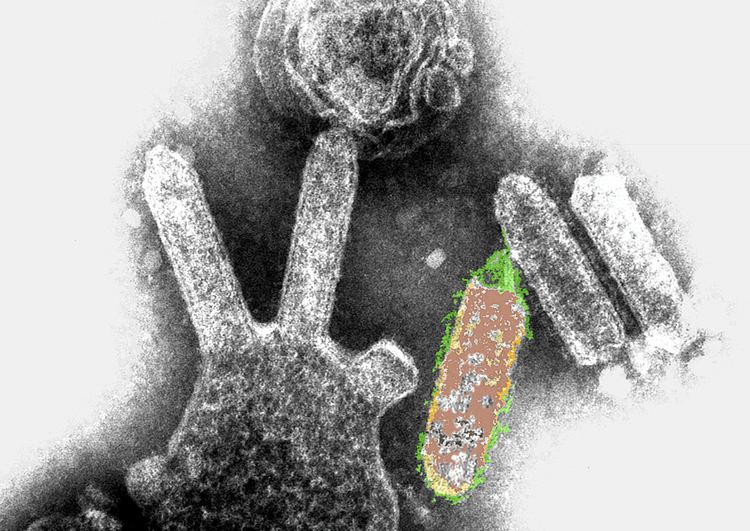Group Group V ((−)ssRNA) | Scientific name Lyssavirus | |
 | ||
Lower classifications Rabies virus, Australian bat lyssavirus, Lagos bat virus | ||
Lyssavirus is a genus of RNA viruses in the family Rhabdoviridae, order Mononegavirales. Humans, mammals, and vertebrates serve as natural hosts. The genus Lyssavirus (from Lyssa, the Greek goddess of madness, rage, and frenzy) includes the rabies virus traditionally associated with that disease.
Contents
Rabies virus neurotropic lyssavirus
Taxonomy
Table legend: "*" denotes type species.
Structure
Lyssavirions are enveloped, with bullet shaped geometries. These virions are about 75 nm wide and 180 nm long. Lyssavirions have helical symmetry, so their infectious particles are approximately cylindrical in shape. This is typical of plant-infecting viruses. Virions of human-infecting viruses more commonly have cubic symmetry and take shapes approximating regular polyhedra.
The structure consists of a spiked outer envelope, a middle region consisting of matrix protein M, and an inner ribonucleocapsid complex region, consisting of the genome associated with other proteins.
Genome
Lyssavirus genomes consist of a negative-sense, single-stranded RNA molecule that encodes five viral proteins: polymerase L, matrix protein M, phosphoprotein P, nucleoprotein N, and glycoprotein G. Genomes are linear, around 11kb in length.
Based on recent phylogenetic evidence, lyssaviruses have been categorized into seven major species. In addition, five more species have recently been discovered: West Caucasian bat virus, Aravan virus, Khujand virus, Irkut virus and Shimoni bat virus. The major species (genotypes) include: rabies virus (genotype 1); Lagos bat virus (genotype 2); Mokola virus (genotype 3); Duvenhage virus (genotype 4); European Bat lyssaviruses type 1 and 2 (genotypes 5 and 6); and Australian bat lyssavirus (genotype 7).
Based on the biological properties of the viruses, these species are further subdivided into phylogroups 1 and 2. Phylogroup 1 includes genotypes 1, 4, 5, 6, and 7, while phylogroup 2 includes genotypes 2 and 3. The nucleocapsid region of lyssavirus is fairly highly conserved from genotype to genotype across both phylogroups; experimental data have shown that the only lyssavirus strains used in vaccinations are those from the first species (i.e. classic rabies) leaving their efficacy for some non-rabies Lyssavirus diseases (e.g. Mokola virus) in question.
Evolution
There are three phylogeographic groups of lyssaviruses: 1 -3. Rabies belongs to group 1, along with Aravan lyssavirus, Australian bat lyssavirus, Bokeloh bat lyssavirus, Duvenhage virus, European bat lyssavirus 1 and 2, Gannoruwa bat lyssavirus, Irkut lyssavirus and Khujand lyssavirus. Members of group 2 include Lagos bat virus, Mokola virus and Shimoni bat virus. Members of group 3 include Ikoma lyssavirus and Lleida bat lyssavirus. Phyogenetic studies suggest that the original hosts of these viruses were bats. The greater antigenic diversity of lyssaviruses from Africa has led to the assumption that Africa was the origin of these viruses. An examination of 153 viruses collected between 1956 and 2015 from various geographic locations has instead suggested a Palearctic origin (85% likelihood) for these viruses. Date estimates (95% likelihood) for the most recent common ancestor were very broad - between 3,995 and 166,820 years before present - which suggests there is further work to be done in this area. Although bats evolved in the Palearctic, their origins antedate that of the lyassaviruses by millions of years, which argues against their co-speciation.
Life Cycle
Viral replication is cytoplasmic. Entry into the host cell is achieved by attachment of the viral G glycoproteins to host receptors, which mediates clathrin-mediated endocytosis. Replication follows the negative stranded RNA virus replication model. Negative stranded RNA virus transcription, using polymerase stuttering, is the method of transcription. The virus exits the host cell by budding and by tubule-guided viral movement. Wild mammals, especially bats and certain carnivores, serve as natural hosts. Transmission routes are typically via bite wounds.
Epidemiology
Classic rabies virus, is prevalent throughout most of the world and can be carried by any warm blooded mammal. The other lyssaviruses have much less diversity in carriers. Only select hosts can carry each of these viral species. Also, these other species are particular only to a specific geographic area. Bats are known to be an animal vector for all identified lyssaviruses except the Mokola virus.
